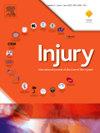Ballistic femoral neck fractures: Associated injuries and outcomes
IF 2.2
3区 医学
Q3 CRITICAL CARE MEDICINE
Injury-International Journal of the Care of the Injured
Pub Date : 2025-02-01
DOI:10.1016/j.injury.2025.112148
引用次数: 0
Abstract
Background: Ballistic fractures of the femoral neck, rare injuries that overwhelmingly affect younger adults, pose significant challenges to the treating surgeon. However, there is limited literature that the treating surgeon can leverage to guide their treatment decisions. The goal of this study is to describe the demographics, associated injuries, outcomes, and complications associated with ballistic femoral neck fractures.
Patients and methods: This retrospective case series, performed at a single, academic, urban, level-one trauma center, evaluated patients with a ballistic fracture of the femoral neck (AO/OTA 31B) between 2003 and 2022. International Classification of Disease codes were utilized to identify patients in the electronic medical record. Chart review was performed to assess patient demographics, associated injuries, success rate of operative and nonoperative intervention, and post-operative complication rate and types.
Results: Seventeen patients were included (94 % male; median age 22.5 years). Median follow up was 12.2 months (range 1–84 months). Five patients (29 %) sustained a concomitant vascular injury. Eight patients (47 %) sustained an additional osseous injury. The median injury severity score was 9 (interquartile range 4–17). Thirteen patients were treated with operative reduction and fixation, 3 patients with incomplete fractures were treated nonoperatively, and one was treated with acute total hip arthroplasty (THA). Overall, 12 of 17 patients (71 %) healed their fracture or had an uncomplicated recovery after acute THA. Of the 13 patients treated with operative reduction and fixation, 8 (62 %) healed their fracture and 5 (38 %) developed one or more post-operative complications.
Conclusions: Nearly 1 in 3 patients with ballistic femoral neck fractures sustain concomitant vascular injury and almost half sustain another osseous injury. In this series, only 62 % of patients who underwent operative reduction and fixation healed their fractures, and nearly 40 % of patients treated with operative reduction and fixation developed a post-operative complication. Given the poor outcomes and high complication rates associated with these injuries, surgeons should counsel patients with ballistic femoral neck fractures accordingly. Further research into the optimal treatment of ballistic femoral neck fractures is needed.
弹道股骨颈骨折:相关损伤和结果。
背景:股骨颈弹道骨折是一种罕见的损伤,主要发生在年轻人身上,给治疗外科医生带来了巨大的挑战。然而,治疗外科医生可以利用有限的文献来指导他们的治疗决策。本研究的目的是描述弹道股骨颈骨折的人口学特征、相关损伤、结局和并发症。患者和方法:本回顾性病例系列,在一个单一的、学术性的、城市的一级创伤中心进行,评估了2003年至2022年间股骨颈弹道骨折(AO/OTA 31B)的患者。利用国际疾病分类代码在电子病历中识别患者。通过图表回顾来评估患者的人口统计学特征、相关损伤、手术和非手术干预的成功率以及术后并发症的发生率和类型。结果:纳入17例患者(94%为男性;中位年龄22.5岁)。中位随访时间为12.2个月(1-84个月)。5例患者(29%)伴有血管损伤。8例患者(47%)继续发生骨损伤。损伤严重程度评分中位数为9(四分位数范围为4-17)。13例采用手术复位固定,3例不完全骨折采用非手术治疗,1例采用急性全髋关节置换术(THA)治疗。总的来说,17例患者中有12例(71%)在急性THA术后骨折愈合或无并发症恢复。在13例接受手术复位和固定治疗的患者中,8例(62%)骨折愈合,5例(38%)出现一种或多种术后并发症。结论:近1 / 3的弹道股骨颈骨折患者伴有血管损伤,近一半患者伴有其他骨损伤。在这个系列中,只有62%的患者接受手术复位和固定后骨折愈合,近40%的患者接受手术复位和固定后出现了术后并发症。考虑到这些损伤的不良预后和高并发症发生率,外科医生应该对弹道股骨颈骨折患者进行相应的咨询。需要进一步研究弹道股骨颈骨折的最佳治疗方法。
本文章由计算机程序翻译,如有差异,请以英文原文为准。
求助全文
约1分钟内获得全文
求助全文
来源期刊
CiteScore
4.00
自引率
8.00%
发文量
699
审稿时长
96 days
期刊介绍:
Injury was founded in 1969 and is an international journal dealing with all aspects of trauma care and accident surgery. Our primary aim is to facilitate the exchange of ideas, techniques and information among all members of the trauma team.

 求助内容:
求助内容: 应助结果提醒方式:
应助结果提醒方式:


